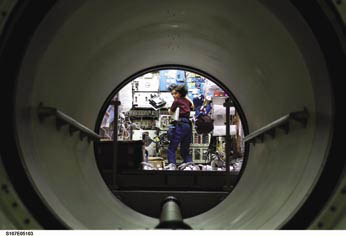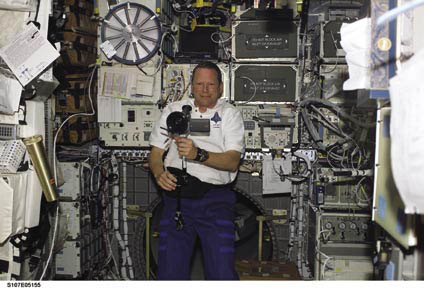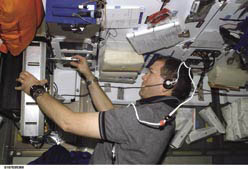2.4 ON-ORBIT EVENTS
2.4 On-Orbit Events
―軌道上での出来事―
―軌道上での出来事―
By 11:39 a.m. EST, one hour after launch, Columbia was in orbit and crew members entered the "post-insertion time-line." The crew immediately began to configure onboard systems for their 16-day stay in space.
打上げから1時間、コロンビアは衛星軌道に到達し、11:39AMから乗員達は「軌道投入後タイムライン」に入りました。彼らは、すぐに16日間の宇宙滞在に備え、オンボードシステムの調整を始めました。
Flight Day 1, Thursday, January 16
飛行第1日目、1月16日(木)
The payload bay doors were opened at 12:36 p.m. and the radiator was deployed for cooling. Crew members activated the Extended Duration Orbiter pallet (containing extra pro-pellants for power and water production) and FREESTAR, and they began to set up the SPACEHAB module (see Fig-ure 2.4-1). The crew then ran two experiments with the Advanced Respiratory Monitoring System stationary bicycle in SPACEHAB.
ペイロードベイのドアは、12:36AMに開かれ、ついで冷却のためにカーゴベイのドアの内側に設置されたラジエーターが展開されました。乗員達はオービターの航続距離延長パレット(これには、水と電気を作るための追加の燃料が入っています)とFREESTARのスイッチを入れ、SPACEHABモジュール(図2-4-1)のセットアップを始めました。次に彼らは呼吸器系モニタリングシステム(Advanced Respiratory Monitoring System)に備え付けられた自転車を使って二つの実験を行いました。

Figure 2.4-1. The tunnel linking the SPACEHAB module to the Columbia crew compartment provides a view of Kalpana Chawla working in SPACEHAB.
図2-4-1:コロンビアの乗務員区画からSPACEHABへとつながるトンネル。
カルパナ・チャウラがSPACEHABで仕事をしているのが見える。
カルパナ・チャウラがSPACEHABで仕事をしているのが見える。
The crew also set up the Bioreactor Demonstration System, Space Technology and Research Students Bootes, Osteoporosis Experiment in Orbit, Closed Equilibrated Biological Aquatic System, Miniature Satellite Threat Reporting System, and Biopack, and performed Low Power Transceiver communication tests.
また、乗員は各実験機器のセットアップを行いました。バイオリアクター実証システム、学生による宇宙技術実験"Bootes"(Space Technology and Research Students Bootes)、軌道上での骨粗しょう症実験(Osteoporosis Experiment in Orbit)、閉鎖平衡状態の水棲生態系に関する実験(Closed Equilibrated Biological Aquatic System), 小型衛星の損傷報告システム(Miniature Satellite Threat Reporting System)、バイオパック(Biopack)などです。さらに低出力のトランシーバーによる通信実験が行われました。
Flight Day 2, Friday, January 17
飛行第2日目、1月17日(金)
The Ozone Limb Sounding Experiment 2 began measuring the ozone layer, while the Mediterranean Israeli Dust Ex-periment (MEIDEX) was set to measure atmospheric aero-sols over the Mediterranean Sea and the Sahara Desert. The Critical Viscosity of Xenon 2 experiment began studying the fluid properties of Xenon.
イスラエルによる地中海上空の砂塵観測実験(Mediterranean Israeli Dust Experiment:MEIDEX)が、地中海とサハラ砂漠上空の大気中のエアロゾルの観測を始め、シャトルによるオゾン層観測実験2(The Ozone Limb Sounding Experiment 2)がオゾン層の計測を始めました。また、キセノンの臨界粘性実験2(The Critical Viscosity of Xenon 2)によるキセノンの流動性についての研究が始まりました。
The crew activated the SPACEHAB Centralized Experiment Water Loop in preparation for the Combustion Module 2 and Vapor Compression Distillation Flight Experiment and also activated the Facility for Absorption and Surface Tension, Zeolite Crystal Growth, Astroculture, Mechanics of Granular Materials, Combined Two Phase Loop Experiment, European Research In Space and Terrestrial Osteoporosis, Biological Research in Canisters, centrifuge configurations, Enhanced Orbiter Refrigerator/Freezer Operations, and Mi-crobial Physiological Flight Experiment.
乗員は実験用集中水循環システムを起動しました。これは、燃焼モジュール2と蒸気圧縮蒸留実験に備えるものです。また彼らは次の実験装置を起動しました。表面張力と吸収に関する実験装置(Facility for Absorption and Surface Tension)、ゼオライト結晶の成長実験(Zeolite Crystal Growth)、植物成長実験(Astroculture)、たんぱく質の結晶化実験(Mechanics of Granular Materials)、複合2相流体ループ実験(Combined Two Phase Loop Experiment)、宇宙と地上における骨粗鬆症に関する欧州実験(European Research In Space and Terrestrial Osteoporosis)、キャニスター内での生物学実験(Biological Research in Canisters)、遠心分離機、改良されたシャトルの冷蔵庫/冷凍庫、微生物の生理学実験(Microbial Physiological Flight Experiment)。
Not known to Mission Control, the Columbia crew, or anyone else, between 10:30 and 11:00 a.m. on Flight Day 2, an object drifted away from the Orbiter. This object, which subsequent analysis suggests may have been related to the debris strike, had a departure velocity between 0.7 and 3.4 miles per hour, remained in a degraded orbit for approximately two and a half days, and re-entered the atmosphere between 8:45 and 11:45 p.m. on January 19. This object was discovered after the accident when Air Force Space Command reviewed its ra-dar tracking data. (See Chapter 3 for additional discussion.)
ミッションコントロールも、シャトルの乗員も、他の誰も知りませんでしたが、2日目の10:30から11:AMの間に、オービターから離れていった物体がありました。この物体の速度は時速0.7〜3.4マイル、半日から2日ほど下降軌道にとどまり、1月19日の8:45AMから11:45AMの間に大気圏に突入しました。その後の分析から、この物体は打上げ時の破片の衝突と関連がある可能性があることがわかりました。この物体は事故後の米空軍の宇宙軍司令部のレーダー追跡データの分析によって発見されました。(より詳しい情報は第3章を参照してください)
Flight Day 3, Saturday, January 18
飛行第3日目、1月18日(金)
The crew conducted its first on-orbit press conference. Be-cause of heavy cloud cover over the Middle East, MEIDEX objectives could not be accomplished. Crew members began an experiment to track metabolic changes in their calcium levels. The crew resolved a discrepancy in the SPACEHAB Video Switching Unit, provided body fluid samples for the Physiology and Biochemistry experiment, and activated the Vapor Compression Distillation Flight Experiment.
乗員達は軌道上での最初の記者会見を開きました。中東上空に厚い雲が掛かっていたため、MEIDEXの目的は果たすことが出来ませんでした。乗員は体内のカルシウム量における新陳代謝の変化を計測する実験を始めました。彼らは、SPACEHABのビデオスイッチングシステムの不具合を修正し、生理学的・生物学的な実験のために体液のサンプルを採集し、蒸気圧縮蒸留実験装置を起動しました。
Flight Day 4, Sunday, January 19
飛行第4日目、1月19日(日)
Husband, Chawla, Clark, and Ramon completed the first ex-periments with the Combustion Module 2 in SPACEHAB, which were the Laminar Soot Processes, Water Mist Fire suppression, and Structure of Flame Balls at Low Lewis number. The latter studied combustion at the limits of flam-mability, producing the weakest flame ever to burn: each flame produced one watt of thermal power (a birthday-cake candle, by comparison, produces 50 watts).
ハズバンド、チャウラ、クラーク、ラモンはSPACEHABの燃焼モジュール2での最初の実験を終了しました。層流炎による煤煙の生成実験(Laminar Soot Processes)、霧状の水による消火実験(Water Mist Fire suppression)、低いルイス数での火球の構造に関する実験(Structure of Flame Balls at Low Lewis number)などです。最後に挙げた実験は、炎が出来る限界での燃焼を研究するものでこれまで作られた中で最も小さな炎を作ります。1つの炎は1ワット程度の熱量しかありません(たとえば、バースデーケーキに立てられるろうそくは50ワットもあります)。
Experiments on the human bodys response to microgravity continued, with a focus on protein manufacturing, bone and calcium production, renal stone formation, and saliva and urine changes due to viruses. Brown captured the first ever images of upper-atmosphere "sprites" and "elves," which are produced by intense cloud-to-ground electromagnetic impulses radiated by heavy lightning discharges and are associated with storms near the Earths surface.
微小重力に対する人体の反応についての実験は、たんぱく質の生成、骨とカルシウムの精製、腎結石の形成、ウィルスによる唾液と尿の変化に注目して継続されました。ブラウンは上層大気での放電現象"スプライト(sprites:妖精)"と"エルブス(elves:エルフ)"の初の映像を捉えました。これは強力な雷の放電によって、地上と雲の間で激しい電磁気のパルスが発生することで生まれるもので、地上近くの嵐と関係しています。
The crew reported about a cup of water under the SPACE-HAB module sub-floor and significant amounts clinging to the Water Separator Assembly and Aft Power Distribu-tion Unit. The water was mopped up and Mission Control switched power from Rotary Separator 1 to 2.
クルーは、SPACEHABモジュールの床下にコップ一杯程度の水が漏れ、水分離器と後部電力供給装置に付着していることを報告しました。水は拭い取られ、ミッションコントロールセンターでは、ロータリー・セパレーターを1番から2番へ切り替えました。
Flight Day 5, Monday, January 20
飛行第5日目、1月20日(月)
Mission Control saw indications of an electrical short on Rotary Separator 2 in SPACEHAB; the separator was pow-ered down and isolated from the electrical bus. To reduce condensation with both Rotary Separators off, the crew had to reduce the flow in one of Columbias Freon loops to SPACEHAB in order to keep the water temperature above the dew point and prevent condensation from forming in the Condensing Heat Exchanger. However, warmer water could lead to higher SPACEHAB cabin temperatures; fortunately, the crew was able to keep SPACEHAB temperatures accept-able and avoid condensation in the heat exchanger.
ミッションコントロールがSPACEHABのロータリー・セパレーター2がショートしている兆候を発見しました。そのため、セパレーターの電源が落とされ、周囲から電気的に切り離されました。ロータリー・セパレーターのスイッチが切られたことによる結露を防ぐために、乗員はSPACEHABに供給されているフロンガスの流量を減らして、凝縮熱交換器内部での凝結をふせぎ、また室温が露点を超えないようにする必要がありました。しかし、温まった水がSPACEHABのキャビン内の温度を上げてしまいました。幸運なことに、乗員達はSPACEHABの室温を許容範囲内に押さえ、熱交換器内部の結露を防ぐことができました。
Flight Day 6, Tuesday, January 21
飛行第6日目、1月21日(火)
The temperature in the SPACEHAB module reached 81 de-grees Fahrenheit. The crew reset the temperature to accept-able levels, and Mission Control developed a contingency plan to re-establish SPACEHAB humidity and temperature control if further degradation occurred. The Miniature Satellite Threat Reporting System, which detects ground-based radio frequency sources, experienced minor command and telemetry problems.
SPACEHABモジュールの室温は華氏81度(摂氏27.2度)まで上がりました。乗員達は室温を許容可能なレベルまで下げ、ミッションコントロールは気温の低下が起こった際に湿度と温度の調整能力を確保するための緊急時の対応計画を作成しました。地上の電波源を検出している小型衛星の損傷報告システムにコマンドとテレメトリーに関して僅かながら問題が発生しました。
Flight Day 7, Wednesday, January 22
飛行第7日目、1月22日(水)
Both teams took a half day off. MEIDEX tracked thunder-storms over central Africa and captured images of four sprites and two elves as well as two rare images of meteoroids enter-ing Earths atmosphere. Payload experiments continued in SPACEHAB, with no further temperature complications.
レッドとブルーの両チームが半日の休暇をとりました。MEIDEXは中央アフリカ上空に雷を伴う嵐を捉え、4つのスプライトと2つのエルブスに加えて、微小天体が地球の大気に突入する瞬間を捉えた非常に珍しい画像を2枚撮影しました。実験はSPECEHABで継続されました。その間、室温の問題は発生しませんでした。
Flight Day 8, Thursday, January 23
飛行第8日目、1月23日(木)
Eleven educational events were completed using the low-power transceiver to transfer data files to and from schools in Maryland and Massachusetts. The Mechanics of Granular Materials experiment completed the sixth of nine tests. Bio-pack shut down, and attempts to recycle the power were un-successful; ground teams began developing a repair plan.
11の教育関連のイベントが、データの送受信に低出力のトランシーバーを利用して、メリーランドとマサチューセッツの学校に向けて行われました。9つの粒状物質の力学実験のうち6番目のものが終了しました。電力のリサイクルを狙ってバイオパックのスイッチが切られましたがうまくいきませんでした。そのため、地上チームは修理計画を作り始めました。
Mission Control e-mailed Husband and McCool that post- launch photo analysis showed foam from the External Tank had struck the Orbiters left wing during ascent. Mission Control relayed that there was "no concern for RCC or tile damage" and because the phenomenon had been seen be-fore, there was "absolutely no concern for entry." Mission Control also e-mailed a short video clip of the debris strike, which Husband forwarded to the rest of the crew.
ミッションコントロールはハズバンドとマックールにメールを送り、打上げの際、外部燃料タンクから剥落した断熱材がオービターの左翼に衝突したことが打上げ後の写真分析から判明したこと伝えました。ミッションコントロールは、これまでにも起きている現象だという理由から「RCCパネルやタイルの損傷の心配はない」とし、「再突入時の心配はまったくない」と述べました。先のメールに加えて、破片が衝突した時の短いビデオクリップがフライトコントロールからメールされ、ハズバンドは他の乗員にそのメールを転送しました。
Flight Day 9, Friday, January 24
飛行第9日目、1月24日(金)
Crew members conducted the missions longest combustion test. Spiral moss growth experiments continued, as well as Astroculture experiments that harvested samples of oils from roses and rice flowers. Experiments in the combustion cham-ber continued. Although the temperature in SPACEHAB was maintained, Mission Control estimated that about a half-gallon of water was unaccounted for, and began planning in-flight maintenance for the Water Separator Assembly.
乗員達はミッション中最も長い燃焼テストを行いました。苔(spiral moss)の成長実験が継続されました。また、ライスフラワーとバラから油をとる植物実験が行われました。燃焼炉の実験が継続して行われ。SPACEHABの室温が調整されましたが、ミッションコントロールの概算では、すでに半ガロン(1.6リットル)の水がなくなっており、飛行中に水分離器のメンテナンスを行う計画を立て始めました。

David Brown stabilizes a digital video camera prior to a press conference in the SPACEHAB Research Double Module aboard Columbia during STS-107.
デビッドブラウンが、コロンビアのSPACEHABリサーチダブルモジュールで行われる
記者会見に備えてデジタルビデオカメラの傾きを調整している。(STS-107)
記者会見に備えてデジタルビデオカメラの傾きを調整している。(STS-107)
Flight Day 10, Saturday, January 25
飛行第10日目、1月25日(土)
Experiments with bone cells, prostate cancer, bacteria growth, thermal heating, and surface tension continued. MEIDEX captured images of plumes of dust off the coasts of Nigeria, Mauritania, and Mali. Images of sprites were captured over storms in Perth, Australia. Biopack power could not be restored, so all subsequent Biopack sampling was performed at ambient temperatures.
骨細胞、前立腺ガン、バクテリアの成長、サーマル・ヒーティング、表面張力の実験が継続して行われました。MEIDEXはナイジェリア、モーリタニア、マリの海岸から流れ出す塵の映像を捉えました。また、オーストラリア、パースの嵐でスプライトが撮影されました。バイオパックの電源は直すことが出来ませんでした。そのため、その後のバイオパックの試料採集は室温で行われました。
Flight Day 11, Sunday, January 26
飛行第11日目、1月26日(日)
Vapor Compression Distillation Flight Experiment opera-tions were complete; SPACEHAB temperature was allowed to drop to 73 degrees Fahrenheit. Scientists received the first live Xybion digital downlink images from MEIDEX and confirmed significant dust in the Middle East. The STARS experiment hatched a fish in the aquatic habitat and a silk moth from its cocoon.
蒸気圧縮蒸留実験が終了し、SPACEHABの室温を華氏73度(摂氏22.8度)に下げることができました。科学者達は初めてMEIDEXからのXybionデジタル送信画像を受信し、中東上空の興味深い塵を確認しました。STARS実験では水槽で魚が孵化し、カイコ蛾が繭から生まれました。
Flight Day 12, Monday, January 27
飛行第12日目、1月27日(月)
Combustion and granular materials experiments concluded. The combustion module was configured for the Water Mist experiment, which developed a leak. The Microbial Physiology Flight Experiment expended its final set of samples in yeast and bacteria growth. The crew made a joint observa-tion using MEIDEX and the Ozone Limb Sounding Experiment. MEIDEX captured images of dust over the Atlantic Ocean for the first time.
燃焼と粒状物質の実験は終了しました。燃焼モジュールは水漏れを修正し、霧状の水を使う実験のために再調整されました。微生物の生理学実験はイースト菌とバクテリアの成長に関する最後のサンプルを使い切りました。乗員はMEIDEXとオゾン層観測実験の共同観測を行いました。MEIDEXは大西洋上空の塵の映像を始めて撮影しました。
Flight Day 13, Tuesday, January 28
飛行第13日目、1月28日(火)
The crew took another half day off. The Bioreactor experi-ment produced a bone and prostate cancer tumor tissue sam-ple the size of a golf ball, the largest ever grown in space. The crew, along with ground support personnel, observed a moment of silence to honor the memory of the men and women of Apollo 1 and Challenger. MEIDEX was prepared to monitor smoke trails from research aircraft and bonfires in Brazil. Water Mist runs began after the leak was stopped.
乗員達は、再び半日の休暇を取りました。バイオリアクター実験によって、骨および前立腺のガンのゴルフボール大の腫瘍が作られました。これは軌道上で作られた最も大きなサンプルです。乗員は地上のサポート員たちと共に、アポロ1号とチャレンジャーの事故で亡くなった男女に敬意を表して黙祷を捧げました。飛行士達はMEIDEXは研究用の飛行機からの煙とブラジルの野火をモニタリングするための準備がなされました。水漏れの修理の後、霧状の水による消火実験が始められました。
Flight Day 14, Wednesday, January 29
飛行第14日目、1月29日(水)
Ramon reported a giant dust storm over the Atlantic Ocean that provided three days of MEIDEX observations. Ground teams confirmed predicted weather and climate effects and found a huge smoke plume in a large cumulus cloud over the Amazon jungle. BIOTUBE experiment ground teams reported growth rates and root curvatures in plant and flax roots different from anything seen in normal gravity on Earth. The crew received procedures from Mission Con-trol for vacuum cleanup and taping of the Water Separator Assembly prior to re-entry. Temperatures in two Biopack culture chambers were too high for normal cell growth, so several Biopack experiments were terminated.
ラモンは、MEIDEXの3日間に渡る観測の成果である、大西洋上空の巨大な塵の嵐についてのレポートを行いました。地上チームは天気や気候影響が予想されたとおりなのを確認し、アマゾン上空の大きな積雲を発見しました。バイオチューブ(BIOTUBE)実験の地上チームは、地上の通常の重力下ではまったく見られない植物と亜麻の根の成長率と根の湾曲についてレポートを行いました。乗員達はミッションコントロールから、再突入の前に行う掃除機に掃除と水分離機のテーピングについての手順書を受け取りました。二つのバイオパックの培養器の温度が通常の細胞の成長には高すぎるため、幾つかの実験が止められました。
Flight Day 15, Thursday, January 30
飛行第15日目、1月30日(木)
Final samples and readings were taken for the Physiology and Biochemistry team experiments. Husband, McCool, and Chawla ran landing simulations on the computer training system. Husband found no excess water in the SPACEHAB sub-floor, but as a precaution, he covered several holes in the Water Separator Assembly
.
生理学と生物化学チームの実験から最後のサンプルと実験結果が得られました。ハズバント、マックール、チャウラはコンピューターによる訓練システムにより着陸シミュレーションを行いました。SPACEHABの床下にはもう水漏れは発見されませんでしたが、ハズバンドは用心のために幾つかある水分離機の開口部を塞ぎました。
Flight Day 16, Friday, January 31
飛行第16日目、1月31日(金)
The Water Mist Experiment concluded and the combustion module was closed. MEIDEX made final observations of dust concentrations, sprites, and elves. Husband, McCool, and Chawla completed their second computer-based landing simulation. A flight control system checkout was performed satisfactorily using Auxiliary Power Unit 1, with a run time of 5 minutes, 27 seconds.
霧状の水による消火実験が終了し、燃焼モジュールが閉じられました。MEIDEXによって砂塵の集中、スプライトとエルブスの最後の観測が行われました。ハズバンド、マックール、チャウラによる二回目のコンピューター上での着陸シミュレーションが終了しました。フライトコントロールシステムのチェックは補助電源装置1を使って問題なく終了しました。チェックにかかった時間は5分27秒でした。
After the flight control system checkout, a Reaction Control System "hot-fire" was performed during which all thrusters were fired for at least 240 milliseconds. The Ku-band antenna and the radiator on the left payload bay door were stowed.
フライトコントロールシステムのチェックの後、リアクションコントロールシステムの「ホット・ファイア」が行われました。これは(テストのために)全てのスラスターを少なくとも240ミリ秒噴かすものです。ペイロードベイの左側のドアに取り付けられたKuバンドアンテナとラジエーターが格納されました。
Flight Day 17, Saturday, February 1
飛行第17日目、2月1日(土)
All onboard experiments were concluded and stowed, and payload doors and covers were closed. Preparations were completed for de-orbit, re-entry, and landing at the Kennedy Space Center. Suit checks confirmed that proper pressure would be maintained during re-entry and landing. The pay-load bay doors were closed. Husband and McCool config-ured the onboard computers with the re-entry software, and placed Columbia in the proper attitude for the de-orbit burn.
全ての実験が終了し実験機器が格納され、積荷のドアとカバーが閉じられました。軌道離脱、再突入、ケネディ宇宙センターへの着陸の準備は全て整いました。宇宙服のチェックが行われ、再突入と着陸に適した与圧が保たれるかどうかが確認されました。ペイロードベイが閉じられました。ハズバンドとマックールは搭載コンピューターと再突入用ソフトウェアを調整し、コロンビアを軌道離脱噴射(de-orbit burn)を行うために適切な軌道へ乗せました。

Rick Husband works with the Biological Research in Canister ex-periment on Columbias mid-deck.
リックハズバンドがコロンビアのミッドデッキで
「キャニスター内での生物学実験」を行っている。
「キャニスター内での生物学実験」を行っている。